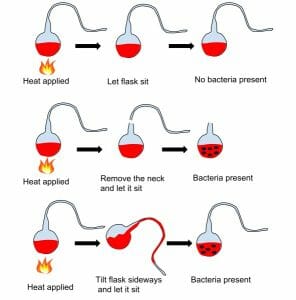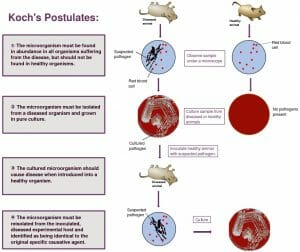Germ Theory Definition
Germ theory of disease is based on the concept that many diseases are caused by infections with microorganisms, typically only visualized under high magnification. Such microorganisms can consist of bacterial, viral, fungal, or protist species. Although the growth and productive replication of microorganisms are the cause of disease, environmental and genetic factors may predispose a host or influence the severity of the infection. For example, in a host that is immunocompromised (e.g., due to AIDS or old age), an infection may result in more severe outcomes than in individuals who are fully immunocompetent.
Who Proposed The Germ Theory of Disease
The notion that diseases could be spread by “seed-like entities” was first described in the 1500’s by Girolamo Fracastoro and were categorized based on how they could be transmitted. Later, Agostino Bassi in the early 1800’s conducted a series of experiments which demonstrated that a disease afflicting silkworms at the time was caused by a parasite. Bassi theorized that disease in humans and animals was also caused by microorganisms. Bassi’s work served to influence Louis Pasteur, who is accredited with the germ theory of disease following his experiments demonstrating the relationship between microorganisms and disease.
The Experiments of Louis Pasteur
Pasteur was the first to experimentally demonstrate that disease was caused by microorganisms in the environment rather than the air itself as proposed by the dominant theory at the time (Miasma theory). This was achieved by exposing freshly boiled broth to air under the following conditions as presented in the diagram below:
- A filter was applied to the vessel containing the growth medium to prevent exposure to particulates.
- The vessel containing the growth medium was exposed to room air without a filter.
- The vessel containing the growth medium was exposed to room air through a long tube that prevented dust particulate from entering (as shown below).
Pasteur found that only when the broth was exposed to room air without a filter did organisms grow in the broth. Therefore, he reasoned that the organisms were not derived from the broth or the air itself, but rather from particulates in the air. The germ theory of disease postulated by Pasteur was later further developed by later scientists, such as Robert Koch.
History of Germ Theory
Early Theories of Disease
In ancient Greece, it was thought that disease was spread not via direct contact with other infected individuals, but rather via infectious “seeds” in the air or food products. Furthermore, such seeds could reside within an individual’s body, causing a subsequent relapse of disease at a later time. This concept was later revisited by scholars in the Middle ages (e.g., Girolamo Fracastoro), who added that disease could be caused by direct or indirect contact, as well as via long distances. The idea that the disease-causing seeds could lie dormant was also further reaffirmed, and many diseases were categorized based on the length of dormancy.
During the 1600’s, the concept that disease was caused by spontaneous generation was experimentally refuted, primarily by the work of Francesco Redi. Redi’s experimental findings were as follows:
- Jar 1: Meatloaf and an egg exposed to the air without a lid.
Results: Maggots covering the egg and meatloaf. - Jar 2: Meatloaf and an egg tightly sealed with a lid.
Results: No maggots. - Jar 3: Meatloaf and an egg with no lid, but the jar was covered with gauze.
Results: Maggots on top of the gauze.
Based on these findings, Redi concluded that the maggots were only found on accessible surfaces and thus, refuted spontaneous generation.
Another early microbiologist from the 1600’s was Anton van Leeuwenhoek, who was the first to directly observe the presence of microorganisms (which he referred to as “animalcules”) through his invention of the first microscope. The notion that disease was caused by creatures that could be visualized only with a microscope was later postulated by Richard Bradley in the 1700’s. This theory was later supported by Marcus Antonius von Plenciz, who wrote a book describing that the diseases caused by microscopic organisms could be further classified into those that were contagious but did not cause epidemics, and those that exhibited both qualities. Von Plenciz further described the ubiquitous presence of microscopic organisms.
Miasma Theory
The predominant theory until germ theory of disease was eventually accepted in the 19th century was termed “miasma theory”, meaning “pollution” or “bad air”. Miasma theory stipulated that disease originated from the decomposition of organic matter, causing a noxious vapor harboring disease-causing agents. Moreover, individuals could contract disease by inhaling foul-smelling air associated with contaminated drinking water, unsanitary conditions, and air pollution.
Key Figures in the Development of Germ Theory
In addition, to the important individuals described above, Ignaz Semmelweis, John Snow, and Robert Koch are also key figures in the development of the germ theory of disease, and the transmission of microorganisms within a population.
Ignaz Semmelweis
Ignaz Semmelweis was an obstetrician in the mid 1800’s who noted a high mortality rate caused by puerperal fever in women giving birth later in the day with the aid of doctors and medical students compared to women who gave birth in the morning and with the aid of midwives. Through his investigation, he noted that the doctors and medical students helping women to give birth had come from conducting autopsies. Semmelweis asserted that the puerperal fever was caused by a disease spread to the pregnant women via the cadavers in the autopsy rooms. Following this realization, Semmelweis implemented mandatory handwashing in a chlorinated solution of lime water prior to assisting with births, and reduced the childbirth mortality rate from 18% to 2.2%. Despite the success of mandatory handwashing, Semmelweis’s theory was rejected by society during this time.
John Snow
Despite a lack of a fully formulated germ theory of disease, John Snow was one of the first to publish an epidemiological study describing the transmission of cholera via the fecal-oral route. In addition, in his description of cholera transmission, he rejected miasma theory, describing that cholera was likely transmitted via the accidental ingestion of the fecal matter from a symptomatic individual. He further stated that the cholera organism could attach to the intestinal lining, multiply, and induce disease in the next host. With this infectious theory of cholera, Snow advised that water be filtered and boiled prior to consumption based on his epidemiological study of the London cholera outbreak of 1854. Through his investigation of the cholera epidemic, a public water pump was identified to be the source of the outbreak and once disabled, served to end the epidemic. Snow demonstrated the association between the cases of cholera and the water pump using a dot map. During his investigation, he found that the pump was suppling water contaminated with sewage, which people were then ingesting. Moreover, it was also found that the location of the pump was situated in close proximity to an inactive cesspit, which was also leaking fecal matter into the pump’s water supply. Despite the validity of Snow’s findings, he too was met with public resistance regarding the possibility of fecal-oral transmission of disease. Nevertheless, his efforts in describing cholera transmission continue to be regarded as one of the most significant events in the field of public health.
Robert Koch
Building on the early work of Louis Pasteur and the germ theory of disease, Robert Koch established the basic scientific requirements used to demonstrate that each specific disease is caused by a specific microorganism. These requirements were based on Koch’s experiments with anthrax isolated from diseased hosts, and are known as “Koch’s Postulates”. Koch’s Postulates consist of the following four rules:
- The microorganism must be identified in all individuals affected by the disease, but not in healthy individuals.
- The microorganism can be isolated from the diseased individual and grown in culture.
- When introduced into a healthy individual, the cultured microorganism should cause disease.
- The microorganism must then be reisolated from the experimental host, and found to be identical to the original microorganism.
A visual representation of Koch’s Postulates can be found below.
Limitations of Koch’s Postulates
While Koch’s Postulates were developed as general guidelines for the identification of infectious causes of disease, there are some inherent limitations that could not be resolved at the time. One of these limitations is the fact that while some of the postulates could be fulfilled, viruses were not yet able to be cultured during the 1800’s. Thus, while it appeared that an infectious agent was responsible for certain diseases, the lack of available techniques to isolate and culture viruses meant that not all Koch’s Postulates could be met. Moreover, the third postulate stipulates that the experimental host “should” exhibit disease, not “must”. This is because asymptomatic carriers, immunity, and genetic resistance are possible. Finally, Koch’s Postulates do not account for prion diseases and other agents that cannot be grown in culture. Therefore, Koch’s Postulates have subsequently been revised to account for recent molecular advances and are no longer an absolute requirement of infectious causality.
Quiz
1. The theory that “bad air” was responsible for disease is:
A. Koch’s postulates
B. “Seeds” theory
C. Miasma theory
D. None of the above
2. John Snow’s observations on the cholera outbreak of 1854 were instrumental in the field of:
A. Obstetrics
B. Public Health
C. Virology
D. A and B
3. Louis Pasteur refuted miasma theory by demonstrating that:
A. A flask containing growth medium supported bacterial growth when a filter was used.
B. A flask containing growth medium did not support bacterial growth when a filter was used.
C. A flask containing growth medium supported bacterial growth when exposed to room air.
D. A flask containing growth medium did not support bacterial growth when a filter was used.
E. A and C
F. C and D
References
- Baxter, Alan G. (2001). Louis Pasteur’s beer of revenge. Nature Reviews Immunology. 1(12): 229-232.
- Buchen, L. (2010). The new germ theory. Nature. 468: 492-495.
- Karamanou M, Panayiotakopoulos G, Tsoucalas G, Kousoulis AA, and Androutsos G. (2012). From miasmas to germs: a historical approach to theories of infectious disease transmission. Le Infezioni in Medicina. 1: 52-56.
- Morris, J. (2016). Re-discovering the germ theory of disease of disease: A major role for proteomics. J. Proteomics Bioinform. 9: 3
Germ Theory


No comments:
Post a Comment